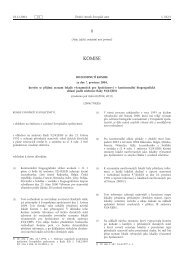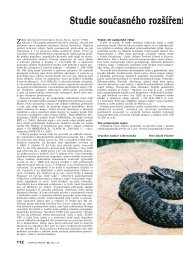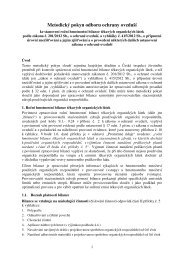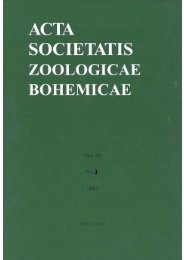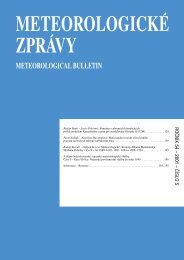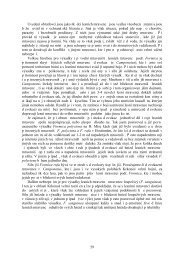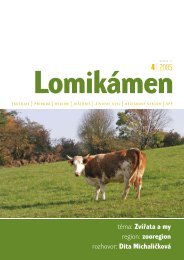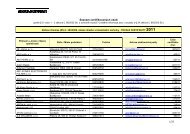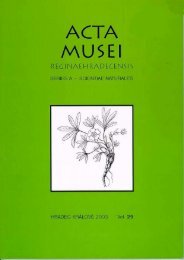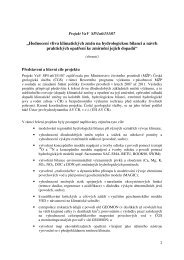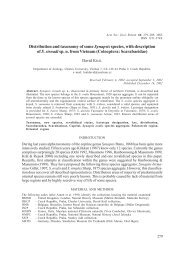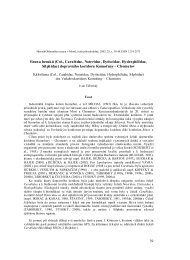journal of forest science
journal of forest science
journal of forest science
You also want an ePaper? Increase the reach of your titles
YUMPU automatically turns print PDFs into web optimized ePapers that Google loves.
plus 2 cm UN (sealing coat). Section IV is formed by 10 cm<br />
OK, which is the surface <strong>of</strong> better quality. The subgrade<br />
layer is broken stone <strong>of</strong> irregular thickness, 40 cm in wheel<br />
tracks except the centre and 25 cm on the roadway margins.<br />
The subsoil is loamy sand on both sections – 6% CBR.<br />
The initial value <strong>of</strong> deflection is the same on both sections,<br />
with slight differences after some time. The course<br />
<strong>of</strong> degradation was more expressive on section III, with<br />
PAH surface, in comparison with section IV.<br />
Section V<br />
Section V follows after section IV. The construction <strong>of</strong><br />
both sections is identical, the main difference is in the<br />
bearing capacity <strong>of</strong> the subsoil; it is sandy loam – 14%<br />
CBR in section V.<br />
The graph illustrates that the initial value <strong>of</strong> deflection<br />
on section V was lower. After some time the deflection<br />
increase and degradation were more rapid and after<br />
10 years they were equal. We can explain this fact by<br />
exposure. Section V is <strong>of</strong> N exposure while section IV is<br />
<strong>of</strong> S, SW exposures.<br />
If we want to compare the obtained results with similar<br />
ones, then this comparison will be difficult.<br />
No literature nor any other scientific sources are available<br />
that studied this problem, i.e. monitoring <strong>of</strong> degradation<br />
by instrumentation on special-purpose<br />
communications where the <strong>forest</strong> roads belong by their<br />
character. The same applies to public roads. Here the solution<br />
<strong>of</strong> a similar problem by the same instrumentation<br />
exists but only from the short-time aspect (1–2 years).<br />
This situation is similar in other countries, too. The degradation<br />
processes are better known in laboratory conditions<br />
but only for individual layers (especially for<br />
bituminous compounds) which were investigated by different<br />
methods and by different instrumentation. It does<br />
not allow to compare the results.<br />
CONCLUSION<br />
The problem <strong>of</strong> roadway degradation on <strong>forest</strong> roads<br />
following the change in bearing capacity has its regularities.<br />
They can be used for the planning <strong>of</strong> repairs or roadway<br />
pavement. Determination <strong>of</strong> roadway degradation<br />
following the change in roadway deflection and its determination<br />
by instrumentation is advantageous because<br />
it detects weak and strong places in the roadway construction.<br />
The visual appreciation is only a complementary<br />
evaluation parallelly to instrumentation.<br />
The knowledge <strong>of</strong> roadway degradation can be used to<br />
calculate “bearing capacity coefficients”. We can predict<br />
the process <strong>of</strong> roadway degradation on the basis <strong>of</strong> these<br />
coefficients as well as we can plan the optimal time <strong>of</strong><br />
roadway repair.<br />
Observations <strong>of</strong> degradation on these sections continue<br />
further and the results will be published after a longer time.<br />
SUMMARY<br />
The knowledge <strong>of</strong> the roadway condition in a network<br />
<strong>of</strong> roads is a crucial parameter for decisions on roadways.<br />
If we know the roadway condition, it is necessary to know<br />
the development <strong>of</strong> roadway degradation (degradation<br />
model).<br />
Deterioration <strong>of</strong> the roadway serviceability is taken as<br />
the roadway degradation.<br />
Wheel traffic, climatic effects, ageing effect, roadway<br />
wear and damage <strong>of</strong> constructional materials influence<br />
the roadway condition.<br />
The sufficient bearing capacity is demanded for the<br />
main <strong>forest</strong> roads first <strong>of</strong> all. The other paramenters such<br />
as evenness (longitudinal and square), roughness are<br />
evaluated as complementary coefficients in <strong>forest</strong> roads<br />
with respect to the average speed <strong>of</strong> vehicles 18 km/h<br />
unlike the public (state) roads.<br />
The roadway degradation on <strong>forest</strong> roads was evaluated<br />
according to changes in roadway bearing capacity<br />
during the time (years) <strong>of</strong> use on the basis <strong>of</strong> changes in<br />
roadway deflection. Old and new roads with bituminous<br />
surface were included in the studied file.<br />
The length <strong>of</strong> an experimental section on the <strong>forest</strong> road<br />
was 300 m. There were 22 sections in total. An arm deflectometer<br />
was used as the measuring equipment. The<br />
reversible roadway deflection was measured with this<br />
instrument under the back axles <strong>of</strong> a vehicle loaded with<br />
10 t. The qualitative condition <strong>of</strong> the section was complemented<br />
by a visual description <strong>of</strong>, for example, the<br />
occurrence <strong>of</strong> pot-holes, cracks and other damage. Measurement<br />
points were determined by random selection at<br />
an average distance <strong>of</strong> 30 m. Deflection was measured in<br />
the spring season after the subsoil defreezing (at the end<br />
<strong>of</strong> March, at the beginning <strong>of</strong> April) when the roadway<br />
has the lowest bearing capacity and when the wear process<br />
is the most expressive. The measurements were repeated<br />
every year. The data were processed by computing<br />
technique.<br />
This article presents the results obtained during 10–<br />
15 year observations <strong>of</strong> degradation.<br />
It is evident from the results that the roadway wear<br />
(degradation), i.e. higher deflection each year, permanently<br />
increases gradually on all experimental sections.<br />
It is represented by polynomials <strong>of</strong> degree I and II.<br />
The roadway degradation is given by the number <strong>of</strong><br />
standard (10 t) axles. At the beginning <strong>of</strong> roadway monitoring<br />
the operating performance was about 100 standard<br />
axles for 24 h. After 15 years <strong>of</strong> use the operating<br />
performance decreased to 5 standard axles for 24 h as<br />
a result <strong>of</strong> roadway degradation.<br />
The results <strong>of</strong> roadway degradation will be used to<br />
determine “wear coefficients” which help to forecast the<br />
roadway degradation and to effectively plan the repair<br />
several years ahead.<br />
J. FOR. SCI., 47, 2001 (7): 314–321 319



